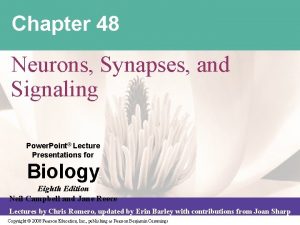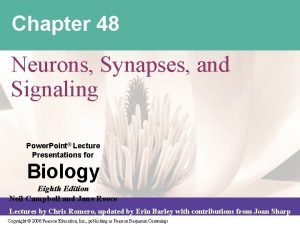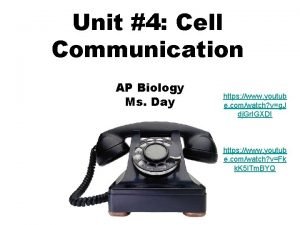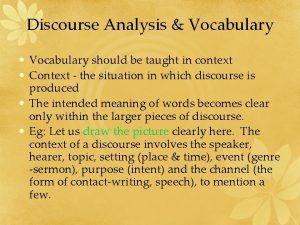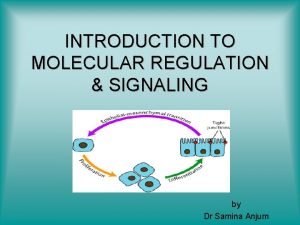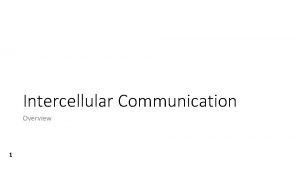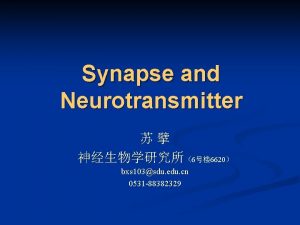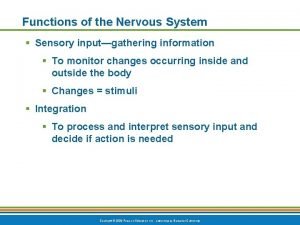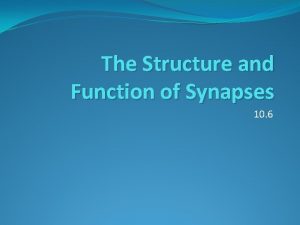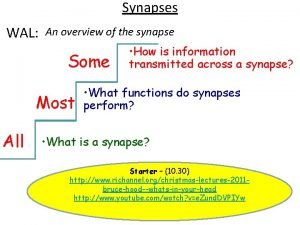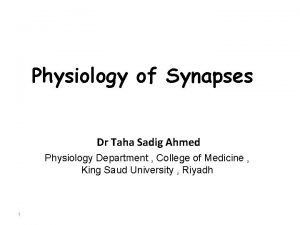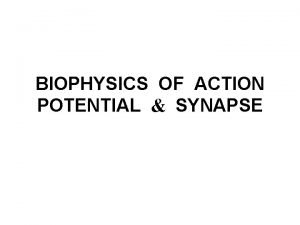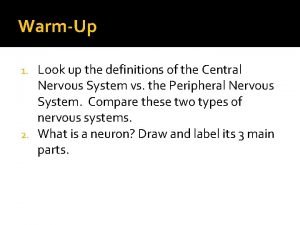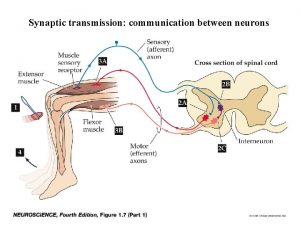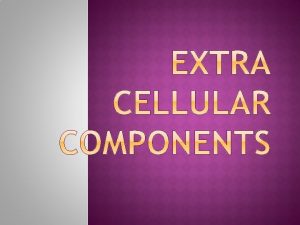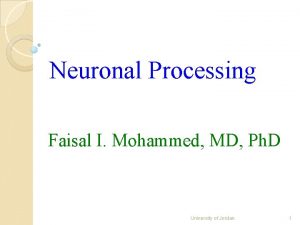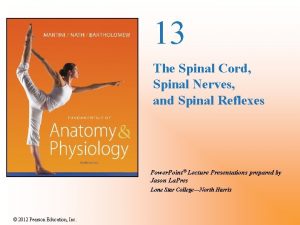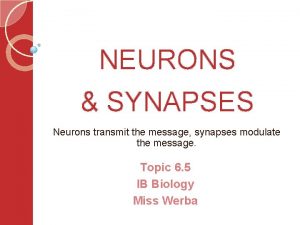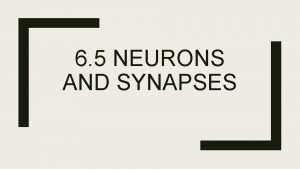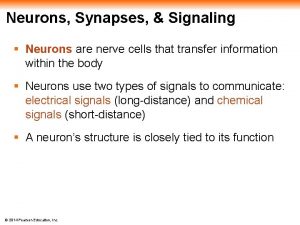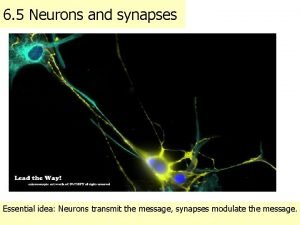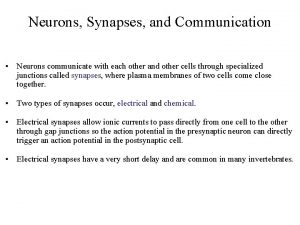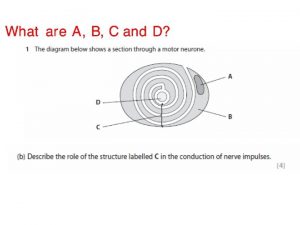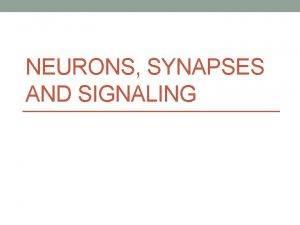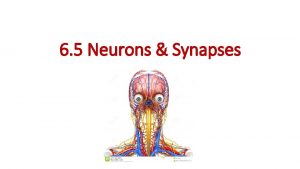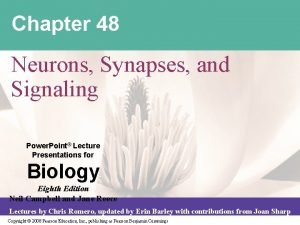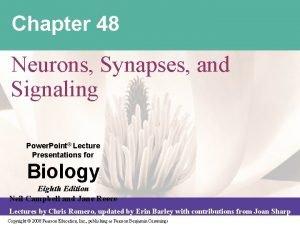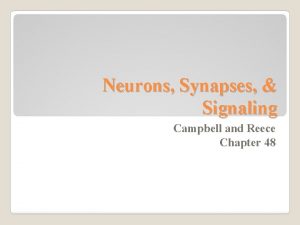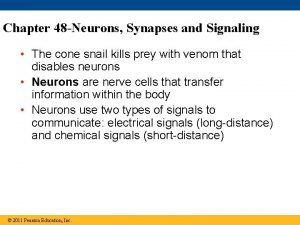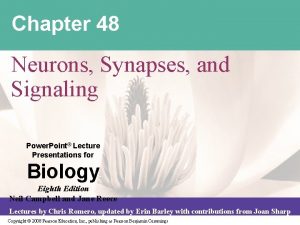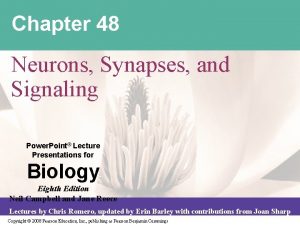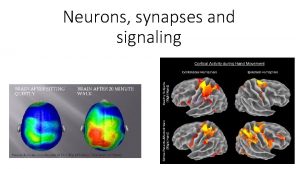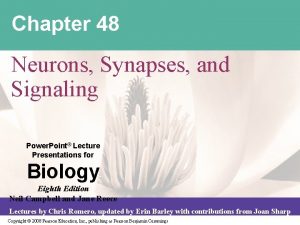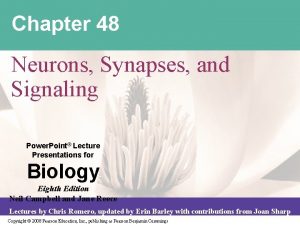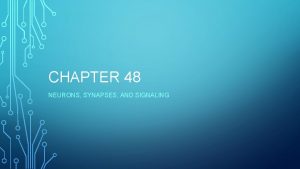Neurons Synapses and Signaling Overview Neural Signals Organization








![Ion Concentrations: § [Na+] 10 x greater outside (main cation outside) § [K+] 30 Ion Concentrations: § [Na+] 10 x greater outside (main cation outside) § [K+] 30](https://slidetodoc.com/presentation_image_h/1162272a682ef139b2e2545f69ba9f13/image-9.jpg)

















- Slides: 26

Neurons, Synapses, and Signaling §Overview §Neural Signals §Organization of Nervous Systems

Functions of Nervous Systems § Sensory input-conduction of signals from receptors to integration centers (CNS) § Integration-interpretation of signals and generation of proper response § Motor output-signals to effector cells (muscles, glands), carry out response


Composition of Nervous System Neurons § cells specialized for transmitting electrical and chemical signals § Composed of cell body, dendrites, and axons § Three types: sensory neurons, interneurons, and motor neurons § Arranged into circuits of two or more kinds of neurons: convergent, divergent, and reverberating circuits



Composition of Nervous System con’t. Supporting Cells (glial cells) § Structurally reinforce, protect, insulate and assist neurons § Do not conduct impulses § Outnumber neurons 10 - to 50 - fold § Types: astrocytes (blood-brain barrier), oligodendrocytes, Schwann cells

The Nature of Neural Signals § Signal transmission along a length of a neuron depends on voltages created by ionic fluxes across neuron plasma membranes § All cells have an electrical membrane potential: range from – 50 to – 100 m. V on the inside. § Neurons have about – 70 m. V at rest
![Ion Concentrations Na 10 x greater outside main cation outside K 30 Ion Concentrations: § [Na+] 10 x greater outside (main cation outside) § [K+] 30](https://slidetodoc.com/presentation_image_h/1162272a682ef139b2e2545f69ba9f13/image-9.jpg)
Ion Concentrations: § [Na+] 10 x greater outside (main cation outside) § [K+] 30 x greater inside (principal cation inside) § [Cl-] 12 x greater outside § Other anions-100 x inside Selective permeability of the membrane maintains these differences


Action Potential-Nerve Impulse Four phases § Resting phase-no channels open § Depolarizing phase-brief reversal of polarity, Na+ gates open Na+ in, result: § -70 m. V to +30 m. V § Repolarizing phase-Na+ gates close, K+ gates open, K+ out, +30 m. V to – 70 m. V § Undershoot phase (refractory period)-K+ and Na+ are returned to proper concentrations, neuron insensitive to depolarizing stimuli

https: //www. youtube. com/watch? v=i. BDXOt_u. HTQ https: //www. youtube. com/watch? v=f. HRC 8 Sl. Lc. H 0

Action Potentials § “all-or-none” require a minimum stimulus or threshold § Self-propagating § Saltatory conduction-action potential “jumps” from one node of Ranvier to the next, skipping the myelinated regions of the membrane



Synapses § Tiny gap between terminal of an axon and beginning of a dendrite on the next neuron § Presynaptic cell-transmitting cell § Postsynaptic cell-receiving cell § Two types of synapses: electrical and chemical

4. The neurotransmitter binds to ligand-gated ion channels in the postsynaptic membrane. In this example, binding triggers opening, allowing Na 2. The 3. The elevated Ca 2+ 1 An action and K+ to diffuse depolarization concentration causes synaptic potential arrives, through. opens voltagevesicles to fuse with the depolarizing gated channels, presynaptic membrane, the presynaptic triggering an influx releasing neurotransmitter into membrane. of Ca 2+. the synaptic cleft.

Chemical Synapses § Separated by synaptic cleft § Ca 2+ enters cell stimulating cytoskeleton to move vesicles to the surface of the axonal knob § Neurotransmitter from the vesicle is released into the cleft § Neurotransmitter binds to receptor sites on the postsynaptic membrane, reestablishing the action potential

Electrical Synapses § Electrical synapse § Less common § Travel through gap junctions § Example-giant neuron in crustaceans

https: //www. youtube. com/watch? v=kq. PGHE 4 Ubew https: //www. youtube. com/watch? v=_ho 4 s. Ikoi. No https: //commons. wikimedia. org/wiki/File: Spinning_Dancer. gif#mediaviewer/Fi le: Spinning_Dancer. gif

neurotransmitters

neurotransmitters § Neurotransmitters are chemical messengers released into the synaptic cleft by neurons § They maintain signals in the nervous system by binding to receptors on post-synaptic neurons and triggering electrical impulses § They also activate responses by effector organs (such as contraction in muscles or hormone release from endocrine glands) § Neurotransmitters may be either excitatory or inhibitory in their effect (some may be both depending on the receptor they bind to) § Excitatory neurotransmitters trigger depolarisation, increasing the likelihood of a response § Inhibitory neurotransmitters trigger hyperpolarisation, decreasing the likelihood of a response

Endorphins § Endorphins are endogenous neuropeptides produced by the pituitary gland that functions as the body’s natural painkiller

Mouse party § http: //learn. genetics. utah. edu/content/add iction/mouse/ § More info on neurotransmitters § http: //ib. bioninja. com. au/options/option-aneurobiology-and/a 5 neuropharmacology/anesthetics. html


http: //www. imdb. com/video/screenplay/vi 13 87790617/
 Chapter 48 neurons synapses and signaling
Chapter 48 neurons synapses and signaling Chapter 48 neurons synapses and signaling
Chapter 48 neurons synapses and signaling Cell signaling overview
Cell signaling overview Communicative signals and informative signals
Communicative signals and informative signals Duality in linguistics
Duality in linguistics Communicative signals and informative signals
Communicative signals and informative signals Vocabulary and organizing of text
Vocabulary and organizing of text Discourse organizing words
Discourse organizing words Autocrine and juxtacrine signaling
Autocrine and juxtacrine signaling Autocrine and juxtacrine signaling
Autocrine and juxtacrine signaling 2 types of synapses
2 types of synapses Nervous cell
Nervous cell Function of synapses
Function of synapses Synapses telecom
Synapses telecom Synapse functions
Synapse functions Renshaw cell inhibition
Renshaw cell inhibition Summation of postsynaptic potentials
Summation of postsynaptic potentials Bioflix how synapses work
Bioflix how synapses work Chemical synapses
Chemical synapses Electrical synapse vs chemical synapse
Electrical synapse vs chemical synapse Synapses
Synapses Spinal cord
Spinal cord Neural circuits the organization of neuronal pools
Neural circuits the organization of neuronal pools What are the characteristics of nervous tissue
What are the characteristics of nervous tissue Babinski sign
Babinski sign What is signal phrasing
What is signal phrasing What action is the ground guide signaling?
What action is the ground guide signaling?
